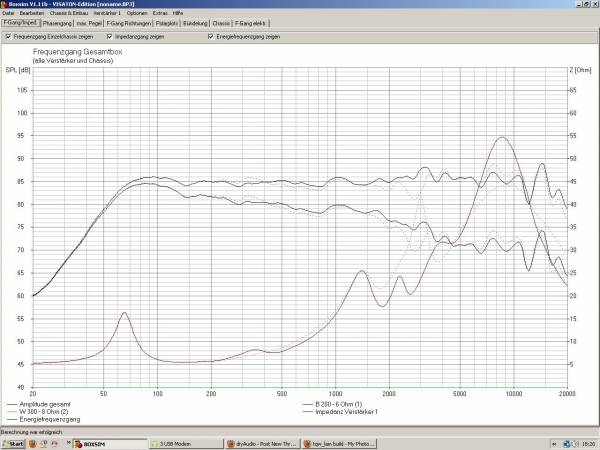well i got bored and decided to see what i could get a B200 from visaton to sim like.....needless to say i used um about 4 notches and some crossover stuff that many FR advocates wont like much, but im really quite pleased with the results....
If anyones interested (despite the >10 crossover components), here is a plot or two.


im not sure i like the peak impedance much though
If anyones interested (despite the >10 crossover components), here is a plot or two.


im not sure i like the peak impedance much though
Hello Mondogenerator.
Like you I enjoy playing around with boxsim a lot.
I have to be blunt though and say despite your reasonably flat freq response your impendance plot and directivity plots show some BIG problems. If you want a speaker with a stable crossover behavior then big impendance swings in the crossover region should be avoided at all costs. If you don't the ragged end of your freq response in real life wil cause big audible distortions and you allready have 9dB swings there which point towards big problems in the tweeter region. A small few ohm peak is allowable but your impendance plot is one of the worst I've ever seen, I'm pretty sure it will mess up your real life speaker performance badly (IMHO). I in general always compensate for the tweeter resonance with an LCR circuit and flatten the impendance slope of the woofer with a zobel network. This gives a flat impendance curve with one a few ohms variation at max, apart from the impendance peak of the woofer resonance which can be left untouched.
A smart way to start in boxsim is to just draw a basic parrallel 2nd order crossover with an LCR for the tweeter and a zobel for the woofer. Just fill in some ballpark figures here for impendance, resistance and capacitance and then run the optimiser. Also reversing the polarity of the tweeter can be agood idea in this case, if you get a big dip or peak around the crossover region then reversing the polarity of the tweeter can do wonders. Also if your tweeter has a bigger sensitivity than you woofer an L-pad attenuation will yield very favourable results.
A good article to start with is this one:
http://sound.westhost.com/lr-passive.htm
It sounds difficult at first but it really isn't. If you can't get trough it, quite probably you won't be able to build a good speaker anyways because this art does need a bit of knowledge to yield good results (no offense). Building a speaker isn't as straight forward as many websites and audiophiles will tell you and crossover design is a true art. Using my method in boxsim will make it a lot easier though 🙂
Like you I enjoy playing around with boxsim a lot.
I have to be blunt though and say despite your reasonably flat freq response your impendance plot and directivity plots show some BIG problems. If you want a speaker with a stable crossover behavior then big impendance swings in the crossover region should be avoided at all costs. If you don't the ragged end of your freq response in real life wil cause big audible distortions and you allready have 9dB swings there which point towards big problems in the tweeter region. A small few ohm peak is allowable but your impendance plot is one of the worst I've ever seen, I'm pretty sure it will mess up your real life speaker performance badly (IMHO). I in general always compensate for the tweeter resonance with an LCR circuit and flatten the impendance slope of the woofer with a zobel network. This gives a flat impendance curve with one a few ohms variation at max, apart from the impendance peak of the woofer resonance which can be left untouched.
A smart way to start in boxsim is to just draw a basic parrallel 2nd order crossover with an LCR for the tweeter and a zobel for the woofer. Just fill in some ballpark figures here for impendance, resistance and capacitance and then run the optimiser. Also reversing the polarity of the tweeter can be agood idea in this case, if you get a big dip or peak around the crossover region then reversing the polarity of the tweeter can do wonders. Also if your tweeter has a bigger sensitivity than you woofer an L-pad attenuation will yield very favourable results.
A good article to start with is this one:
http://sound.westhost.com/lr-passive.htm
It sounds difficult at first but it really isn't. If you can't get trough it, quite probably you won't be able to build a good speaker anyways because this art does need a bit of knowledge to yield good results (no offense). Building a speaker isn't as straight forward as many websites and audiophiles will tell you and crossover design is a true art. Using my method in boxsim will make it a lot easier though 🙂
What are you using as a starting point? I have seen quite a shift in parameters of these (and one would assume FR) over the years i have been treating them.
Many of those components could likely be eliminated by installing phase plugs.
dave
Many of those components could likely be eliminated by installing phase plugs.
dave
- Status
- Not open for further replies.